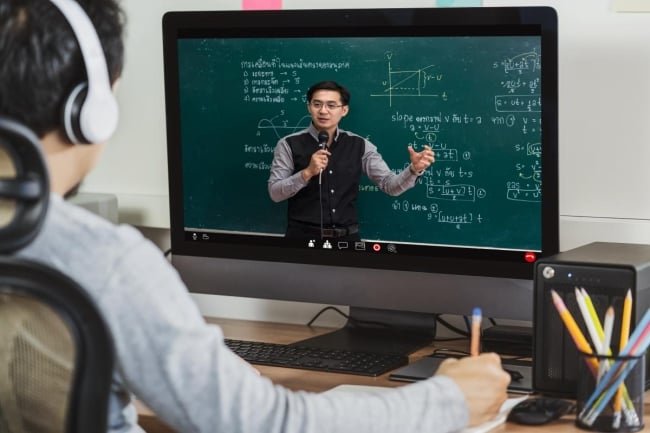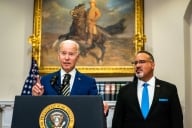You have /5 articles left.
Sign up for a free account or log in.

Even faculty who are sympathetic to students’ desires for recorded lectures worry about an abundance of video surveillance.
Tzido/Getty Images
When Martha Alibali, professor of psychology at the University of Wisconsin at Madison, first used lecture-capture technology last spring, she worried that her efforts might suppress in-person attendance. Many students still participated in the live class, and they shared thoughts about the policy in conversation and end-of-semester course evaluations.
Those who appreciated the recordings included: students with COVID-19, long COVID, or other health struggles; athletes who traveled for competitions; those who needed to travel for important family events or emergencies; those fasting for Ramadan; one seeking to avoid encountering someone in the building who had harassed her in the past; students for whom English was their second language who wanted to relisten to the lectures; and students reviewing material before exams. Alibali had 109 students; the most watched lecture video was viewed 84 times, and the least watched lecture video was viewed 34 times.
“I was astonished how many times the videos were viewed,” Alibali wrote. “And I did not receive a single email asking me if we ‘did anything important’ in lecture.”
The COVID-19 pandemic introduced in-person students to remote, flexible attendance made possible by recorded lectures. Though vaccines have largely made face-to-face learning possible again, recorded lectures have endured at many institutions. Proponents argue that recorded lectures offer support and flexibility for students in need of reasonable accommodations due to illness, work or family responsibilities. They also see recordings as a supplemental resource for all students during study.
But others argue that recorded lectures inhibit class discussion, compromise student privacy and raise sometimes-unanswered questions about intellectual property. They also fear that access to recordings invite abuse by students seeking to avoid class for unsanctioned reasons. Amid this debate, learning and classroom policies are morphing in real time.
“Silicon Valley is fond of … ‘problem plus technology equals better,’” Neil Richards, professor of law at Washington University in St. Louis, said. “Anyone who’s even been paying remote attention to what’s happened with digital policy in the evolution of the internet and digital communications technologies over the past 25 years knows that’s just not the case. It’s very, very rare that a new technology will be easily deployed, will solve all of our problems and not create new ones.”
Richards’s students have shared that class recordings “chill their willingness to engage, struggle with difficult material and make mistakes,” especially when discussing controversial topics such as abortion law. He records lectures only in special circumstances, such as when a student requires accommodations due to a disability or during weather emergencies.
But some faculty members, including those who have updated their teaching practices since the start of the pandemic, view class recordings as a public health imperative.
“I am recording all of my classes to encourage students who do not feel well to stay home,” Ann Bartow, law professor at the University of New Hampshire, wrote in an email. “Nobody at my law school is wearing masks and covid remains extant. I have had six or seven students call out sick with COVID already in the first two weeks of class.”
Professors today are in a period of transition. Many are attempting to balance students’ legitimate need for flexibility, given all that has transpired during the pandemic, with what they have historically believed—and many continue to believe—is the best practice for teaching and learning. Many faculty members who record lectures to foster accessibility recognize that students engage differently—often in unproductive ways—with recorded lectures. They sometimes skip parts or watch at double speed. If they watch without having attended class, they pre-emptively forgo the opportunity to ask questions.
This means that many professors who record their lectures do so to offer students latitude about whether to attend in person. At the same time, they develop and communicate policies—sometimes quite restrictive—establishing in-person class as the default. Toni Weiss, senior professor of practice in the Tulane University’s economics department, for example, records class via Zoom but does not consider remote attendees full participants.
“I let [students] know that I am there to engage with the people in the room, so while they are free to Zoom in, I won’t be looking at the chat or interacting with the Zoom people,” Weiss recently wrote on the Professional and Organizational Development Network open discussion group. Weiss only allows each student to attend via Zoom up to three times each term out of concern that they may do so for unsound reasons; students can surpass the limit only if they document legitimate reasons.
Some faculty members who have offered their students recorded lectures have experienced steep declines in in-person attendance. For example, University of Massachusetts at Dartmouth biology lecturer Ben Winslow tweeted that recorded lectures led to “30 percent attendance and very few views on recordings.” Also, Rachel Germain, a University of British Columbia assistant professor of zoology, tweeted that recorded lectures made it “hard to have any kind of active learning activity.”
The optics and sound quality of recorded in-person lectures are also sometimes subpar. When the camera is set up in the back of the room, the recording often includes the backs of many students’ heads, which can interrupt the view of what’s happening in the front of the room. That’s not all bad, Alibali noted, as the vantage point fosters a degree of anonymity to students who show up in the classroom.
Some institutions, in recognition of the “fluidity of the epidemiological situation on campus,” have offered faculty members detailed guidance on making effective, equitable decisions about access to lecture recordings.
For example, the University of Rochester’s academic policy document, which was updated in August 2022, uses the word “record” 41 times in 16 pages. Video recordings of office hours are discouraged, but faculty members are required to provide lecture recordings or Zoom access to students who miss class due to illness or who need to isolate in place. For politically charged or sensitive class discussions, live, nonrecorded Zoom access is recommended over recordings.
Instructors may enforce in-person attendance policies for those who are not ill or quarantining due to COVID, though they are not permitted to ask students to document illnesses. When class is recorded, instructors are expected to notify students by way of a statement on the syllabus (the preferred method), verbally in the first several classes or in a one-time email to all students. Once all students in the course have received final letter grades, faculty members may delete videos.
“The pandemic has really changed the college landscape for students,” said Alison Kelly, assistant professor of psychology at the University of North Dakota, who co-authored a study published this year on supporting students in the transition from emergency remote teaching back to in-person learning. “They are aware that mental health challenges are here to stay. During the pandemic, they had access [to recorded lectures]. Why shouldn’t that continue?”
Students’ work and study habits changed during remote teaching. The top-two pandemic-era policies they would like to see continued are access to course content (such as video lectures and notes) and flexibility (in attendance policies and due dates), according to the study. During the transition back to in-person learning, many expressed concern about finding reliable transportation to attend class or not being able to slow down or replay an in-class discussion.
Some faculty members, however, are concerned that recorded lectures signal the “Netflixization of academia,” in which they are either spied on or made obsolete.
“I don’t record lectures in order to protect our rights as workers,” Akwugo Emejulu, professor of sociology at the University of Warwick in the United Kingdom, wrote in a tweet, noting that U.K. higher education is engaged in a protracted labor dispute. “When we withdraw our labour during strikes, no recordings means our past selves can’t be transformed into scabs by management. This is trade unionism 101.”
To this end, some professional associations, including the American Association of University Professors, articulated principles early in the pandemic to guide higher education’s response to the global emergency, including how class recordings may be used.
“Institutions should not take this opportunity to appropriate intellectual property to which they would not otherwise have had access,” the statement said. “Teaching materials moved online because of the one-time emergency created by COVID-19 are not the property of the institution for future use.”
Even faculty who are sympathetic to students’ desires for recorded lectures worry about an abundance of video surveillance. Since the fall of 2021, North Carolina State University has recorded lectures by default. Faculty members who are concerned about storing “not just lectures but every casual remark, every student comment and question” can opt out. But ensuring that the opt-out process was simple required faculty pushback, according to John Millhauser, associate professor of anthropology at N.C. State.
“It’s still disquieting to me that it is opt out as opposed to opt in,” Millhauser said. “This is where the black box of university administration comes in. I don’t know where the decision was made to go opt in versus opt out and whether that was one done with faculty consultation or not.”
The question of whether to record lectures exists at the confluence of conversations about disability accommodations, academic support, student privacy and professors’ intellectual property.
“These are not the kinds of problems where an absolutist solution—either ‘I will never record under any circumstances’ or ‘I will record everything and post it to the web’—is appropriate,” Richards said. “We need nuanced, thoughtful solutions that craft and achieve the kinds of mission-appropriate, program-appropriate learning communities that we want.”




